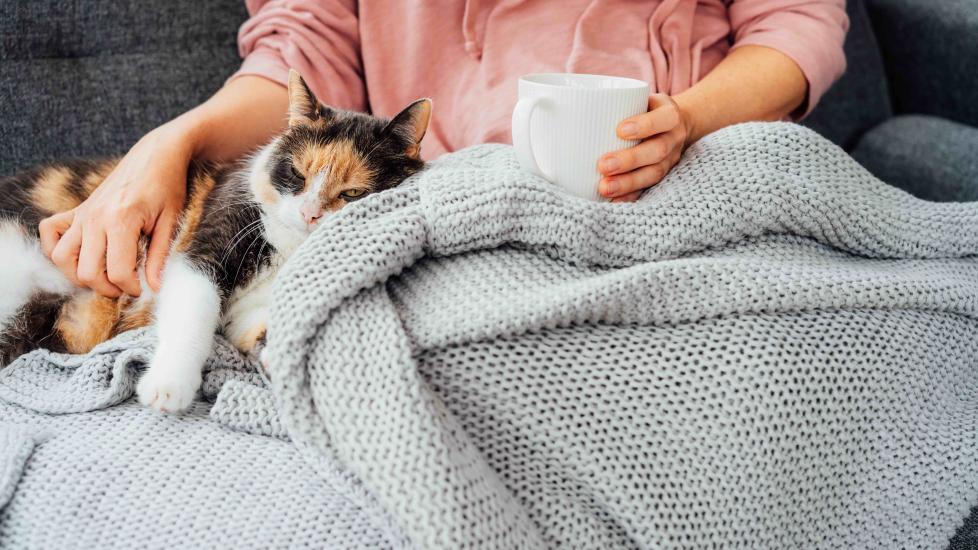Why Is My Cat So Cuddly and Affectionate?
Adobe Stock/okrasiuk
Many people think of cats as being aloof, picky, and generally lacking in affection compared to dogs. However, there are some cats that rival a love-struck pooch when it comes to showing and showering affection.
Key Takeaways
- Cats show affection in different ways, such as rubbing against you, following you, or sleeping near you.
- A cat’s cuddliness may be influenced by both genetics and socialization.
- Certain breeds are known for being more affectionate, such as Siamese, Ragdolls, and Persians.
- A sudden increase in affection can have various causes, including medical issues.
- If your cat becomes unusually clingy or shows other symptoms like excessive vocalization, schedule a vet appointment.
Why Is My Cat So Cuddly and Affectionate?
Sociability in cats varies a lot, meaning there are some cats that are aloof—but others love to show affection to their family members, other feline housemates, and even the family dog. Sometimes cat parents even talk about how their clingy cats won’t leave them alone.
Cats can be affectionate and cuddly toward the people they’re bonded to. Through experience, cats learn that being close to their humans feels good—being petted, given a treat, or even just talked to bring pleasure.
How Do Cats Show Affection?
Cats show affection in a few different ways:
-
With their body language; they will arch against your hands or rub against your legs
-
Placing their front paws on you to solicit physical attention
-
Sitting next to you on the couch
Are Some Cats More Affectionate Than Others?
Your cat’s affection may be partially attributed to the close human-animal bond, but part may be due to genetics.
A study found that kittens with a friendly father grow up to be cats that are friendlier toward people compared to cats with a non-friendly father. But cats with a friendly father who also received socialization were friendlier compared to cats with a friendly father who were not socialized.
Single cats may also seek their pet parents’ attention more often because they do not have a feline companion for social interactions and play.
Clingy Cat Breeds
Some cat breeds have a reputation for being affectionate and clingy. These cats were specifically selected for certain desirable physical and behavioral characteristics that people find appealing—one of which is their desire to seek attention from people.
Some more “clingy” cat breeds are:
Why Is My Cat Suddenly Affectionate?
There are several reasons why a cat may suddenly become more affectionate than usual.
1. You’ve Returned Home
If you were away for a while, your cat may exhibit more affection toward you for the next several days after you’ve returned home. For example, they may follow you around and meow to seek attention.
2. It’s Dinner Time
Some cats express a lot of affection around mealtimes. They are hungry and have learned that meowing and rubbing against you are behaviors that likely get them fed around that time every day.
3. Your Cat Is in Heat
Unspayed female cats will exhibit more affectionate behavior when they go into heat. Sometimes the behavior can be directed toward you or other pets in the household.
Should You Worry About an Overly Affectionate Cat?
A sudden increase in some affectionate behaviors, such as vocalizations or asking for attention, are reasons to take your cat to the vet for an exam.
For instance, some cats that develop hyperthyroidism become more active and affectionate. Cats that initially develop diabetes mellitus may also be more affectionate and vocal because they are hungry all the time and are not getting the energy they need from their diet.
Older cats may suddenly become more affectionate and vocal as they age and potentially develop hypertension or cognitive dysfunction.
It’s best to talk to your vet about any sudden changes in your cat’s behavior, as there could be a medical cause.
Clingy Cats FAQs
Are cuddly cats normal?
Yes, it’s normal for some cats to be cuddly. Some cats form deep attachment to their pet parents and express their love physically.
Why is my cat so needy at night?
Your cat may want to cuddle and seek attention from the you later in the evening, especially if they live in a single-cat household.
It may also be related to human behavior; most people are sedentary after dinner. This is the perfect time for our cats to get extra attention, when you’re not running around the house engaged in other activities.
Why is my cat so clingy after being spayed?
If your cat appears clingy right after being spayed, it may be that they are in pain and uncomfortable following surgery want you to comfort them. They may also need additional pain medication and should be examined by their veterinarian to make sure they have adequate pain control.
